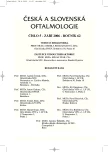Clinical Appearance and Outcome of Zone 1 ROP
Authors:
M. Odehnal; J. Malec; M. Hložánek; D. Dotřelová
Authors‘ workplace:
Oční klinika dětí a dospělých UK 2. LF a FN Motol, Praha
přednosta doc. MUDr. Dagmar Dotřelová, CSc.
Published in:
Čes. a slov. Oftal., 62, 2006, No. 5, p. 316-323
Overview
The goal of this clinical trial was to evaluate outcomes of the treatment of retinopathy of prematurity (ROP) located in zone 1 (Zone 1 ROP). This disease has a specific clinical appearance and poor prognosis. Usually it is difficult to identify particular stages of ROP and to indicate treatment while following progression of the disease. In the group of zone 1 ROP it is necessary to separate transient forms (TF), in which vascularizations reach edges of zone 2, from very posterior forms (VPR), in which vascularizations and pathological changes are present only in zone 1.
There were 24 eyes with zone 1 ROP (15 children) treated with combination of transcleral laser photocoagulation and cryotherapy during the years 2000 till 2005 in our series. Five eyes suffered from VPR, 19 eyes from TF. Average follow –up was 24 months. We found better outcomes in eyes with TF treated in prethreshold stage of ROP (10 eyes) than in threshold stage of ROP (9 eyes). All 5 eyes with VPR developed unfavourable ROP stage IV or V.
Zone 1 ROP becomes diagnostic and therapeutic challenge considering growing incidence of surviving of newborns with low or very low birth weight. Treatment initiation during prethreshold stage of ROP as it is supported by ETROP study (Early treatment of ROP) seems to be promising.
Key words:
zone 1 retinopathy of prematurity, cryotherapy, laser photocoagulation, transient form of Zone 1 ROP, very posterior form of Zone 1 ROP
Labels
OphthalmologyArticle was published in
Czech and Slovak Ophthalmology

2006 Issue 5
Most read in this issue
- The Use of Accommodative Lenses for Surgical Correction of the Presbyopia Using the Prelex Method
- Clinical Appearance and Outcome of Zone 1 ROP
- Ocular Symptoms as an Indication for Carotid Endarterectomy
- The Quality of Vision in Premature Infants – First Results
